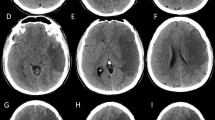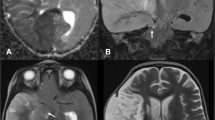Abstract
Background
Decompressive hemicraniectomy (DHC) can be lifesaving in hemispheric stroke complicated by cerebral edema. Conversely, osmotic agents have not been shown to improve survival, despite their widespread use. It is unknown whether medical measures can similarly confer survival in certain patient subgroups. We hypothesized that osmotic therapy (OT) without DHC may be associated with a greater likelihood of survival in particular populations depending on demographic, radiologic, or treatment characteristics.
Methods
We performed a retrospective cohort analysis of patients with large anterior circulation strokes with an NIH stroke scale (NIHSS) ≥10 who received OT. We compared clinical, radiologic, and treatment characteristics between two groups: (1) those who survived until discharge with only OT (medical management success) and (2) those who required either DHC or died (medical management failure).
Results
Thirty patients met eligibility criteria. Median NIHSS was 19 [interquartile range (IQR) 13–24], and median GCS was 10 [IQR 8–14]. Forty-seven percent of the medical management cohort survived to discharge. Demographic characteristics associated with medical management success included NIHSS (p = 0.009) and non-black race (p = 0.003). Of the various interventions, the administration of OT after 24 hours and a smaller hypertonic saline dose was also associated with survival to discharge (p = 0.038 and 0.031 respectively).
Conclusion
Our results suggest that patients with moderate size hemispheric infarcts on presentation and those who do not require OT within the first 24 h of stroke may survive until discharge with medical management alone. Black race was also associated with conservative management failure, a finding that may reflect a cultural preference toward aggressive management. Further prospective studies are needed to better establish the utility of medical management of hemispheric edema in the setting of moderate size hemispheric infarcts.


Similar content being viewed by others
References
Hays AN, Lazaridis C, Neyens R, et al. Osmotherapy: use among neurointensivists. Neurocrit Care. 2011;14:222–8.
Jauch EC, Saver JL, Adams HP, et al. Management of patients with acute ischemic stroke: a guideline for healthcare professionals from the American Heart Association/American Stroke Association. Stroke. 2013;44:870–947.
Vahedi K, Hofmeijer J, Juettler E, et al. Early decompressive surgery in malignant infarction of the middle cerebral artery: a pooled analysis of three randomised controlled trials. Lancet Neurol. 2007;6:215–22.
Juttler E, Unterberg A, Woitzik J, et al. Hemicraniectomy in older patients with extensive middle-cerebral-artery stroke. NEJM. 2014;370:1091–100.
Akins PT, Guppy KH. Sinking skin flaps, paradoxical herniation and external brain tamponade: a review of decompressive craniectomy management. Neurocrit Care. 2008;9(2):259.
Cruz-Flores S, Berge E, Whittle IR. Surgical decompression for cerebral oedema in acute ischaemic stroke. Cochrane Database Syst Rev. 2012;1:CD003435.
Hofmeijer J, Kapelle LJ, Algra A, et al. Surgical decompression for space-occupying cerebral infarction (the hemicraniectomy after middle cerebral artery infarction with life-threatening edema trial [HAMLET]: a multicentre, open, randomised trial. Lancet Neurol. 2009;8:326–33.
Vahedi K, Vicaut E, Mateo J. Sequential-design, multicenter, randomized, controlled trial of early decompressive craniectomy in malignant middle cerebral artery infarction (DECIMAL Trial). Stroke. 2007;38:2506–17.
Juttler E, Schwab S, Schmiedek P, et al. Decompressive surgery for the treatment of malignant infarction of the middle cerebral artery (DESTINY): a randomized, controlled trial. Stroke. 2007;38:2518–25.
Berecski D, Liu M, do Prado GF, et al. Cochrane report: a systematic review of mannitol therapy for acute ischemic stroke and cerebral parenchymal hemorrhage. Stroke. 2000;31:2719–22.
Kamel H, Navi BB, Nakagawa K, et al. Hypertonic saline versus mannitol in the treatment of elevated intracranial pressure: a meta-analysis of randomized clinical trials. Crit Care Med. 2011;39(3):554–9.
Bereczki D, Mihalka L, Szatmari S, et al. Mannitol use in acute stroke case fatality at 30 days and 1 year. Stroke. 2003;43:1730–5.
Candelise L, Colombo A, Spinnnler H. Therapy against brain swelling in stroke patients: a retrospective clinical study on 227 patients. Stroke. 1975;6:352–6.
Santambrogio S, Martinotti R, Sardella F, et al. Is there real treatment for stroke? Clinical and statistical comparison of different treatments in 300 patients. Stroke. 1978;9:130–2.
Adams HP, Davis PH, Leira EC, et al. Baseline NIH stroke scale score strongly predicts outcome after stroke: a report of the trial of org 10172 in acute stroke treatment (TOAST). Neurology. 1999;53(1):126.
Rordorf G, Koroshetz W, Efird J, et al. Predictors of mortality in stroke patients admitted to an intensive care unit. Crit Care Med. 2000;28(5):1301–5.
Kim H, Jin ST, Kim YW, et al. Predictors of malignant brain edema in middle cerebral artery infarction observed on CT angiography. J Clin Neurosci. 2015;22:554–60.
Woo D, Broderick JP, Kohtari RU, et al. Does the national institutes of health stroke scale favor left hemisphere strokes? Stroke. 1999;30:2355–9.
Battey TWK, Karki M, Singhal AB, et al. Brain edema predicts outcome after nonlacunar ischemic stroke. Stroke. 2014;45:3643–8.
Choi HA, Fernandez A, Jeon SB, et al. Ethnic disparities in end-of-life care after subarachnoid hemorrhage. Neurocrit Care. 2015;22(3):423–8.
Barnato AE, Anthony DL, Skinner J, et al. Racial and ethnic differences in preferences for end-of-life treatment. J Gen Intern Med. 2009;6:695–701.
Rubin MA, Dhar R, Diringer MN. Racial differences in withdrawal of mechanical ventilation do not alter mortality in neurologically injured patients. J Crit Care. 2014;29:49–53.
Author information
Authors and Affiliations
Corresponding author
Ethics declarations
Conflict of interest
The authors report no relevant disclosures.
Rights and permissions
About this article
Cite this article
Ong, C.J., Keyrouz, S.G. & Diringer, M.N. The Role of Osmotic Therapy in Hemispheric Stroke. Neurocrit Care 23, 285–291 (2015). https://doi.org/10.1007/s12028-015-0173-2
Published:
Issue Date:
DOI: https://doi.org/10.1007/s12028-015-0173-2




